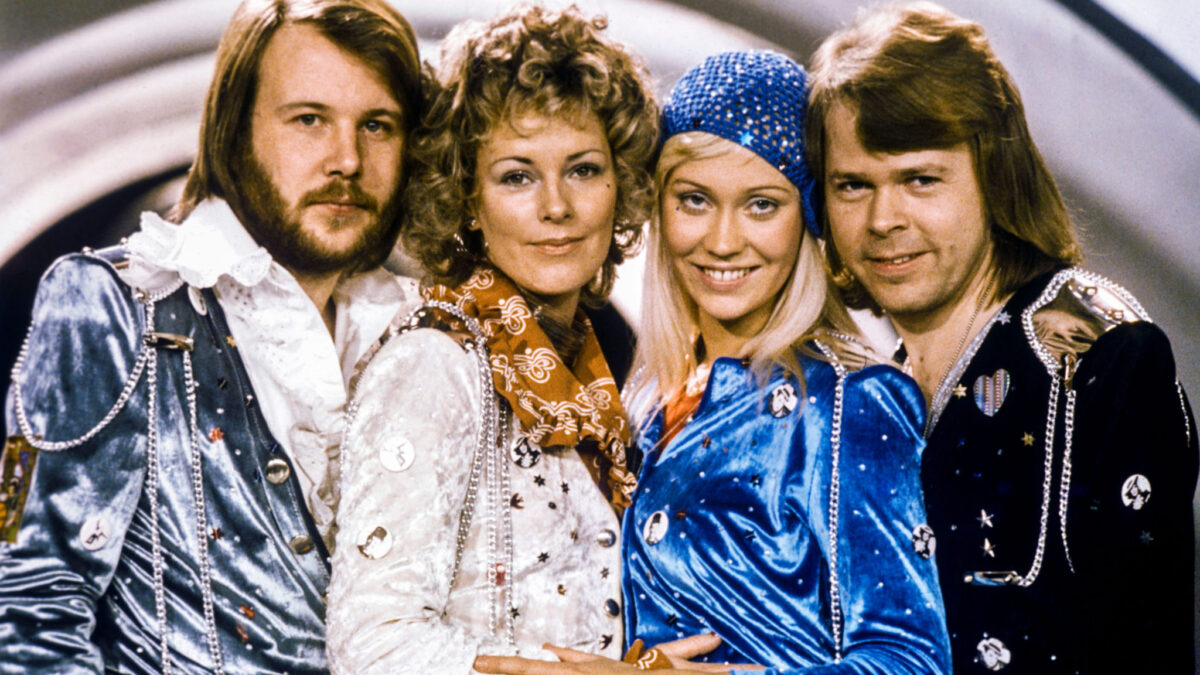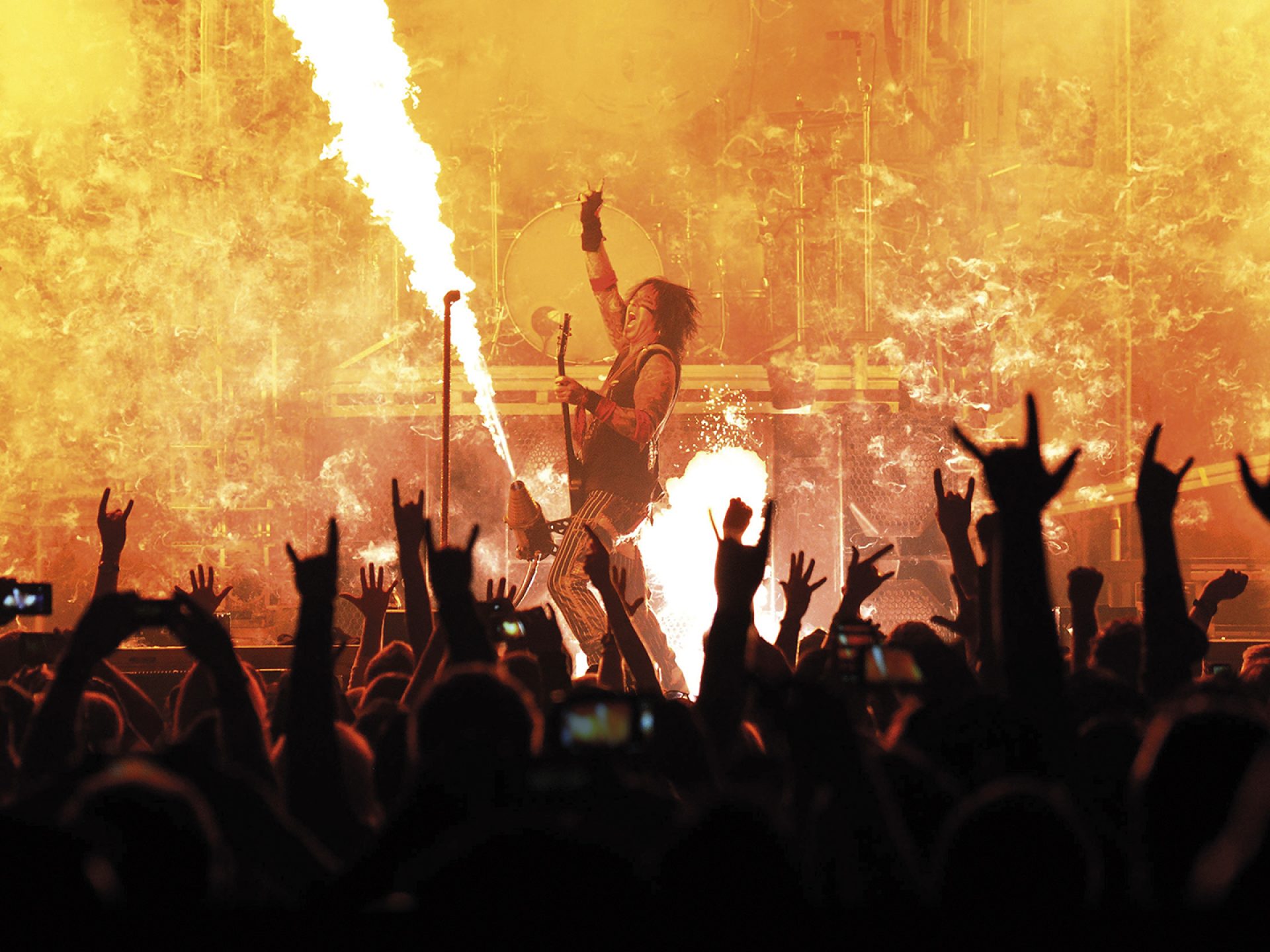Magazine

May 12, 2021

This article was originally published in Populous Magazine, our biannual publication featuring news and trends from the worlds of sport, entertainment, and major public events. Find out more, and sign up to receive a free copy, here.
Prevented from performing live for over a year, some of the world’s loudest rock bands are now preparing world tours. To celebrate, we pinpoint the key hallmarks of great stadium rock, from mosh pits and crowd surfing to backstage parties and airborne TV sets.
Invented at punk concerts in the late 1970s, moshing (or slam dancing) is a frenzied, aggressive form of dancing which involves slamming one’s body against other fans. Counter-intuitively, for many concert-goers, it’s a form of social bonding rather than hostility, even if it occasionally results in accidental injury.
Modern health and safety considerations may have tamed its physicality, yet it remains popular. The height of the action occurs in what’s known as the mosh pit – the central area of the audience, close to the stage. “The ultimate physical expression of rock ‘n’ roll’s pure power and energy,” is how rock magazine Kerrang! describes moshing.
Another wondrous expression of abandon at concerts is crowd surfing, where fans allow themselves to be carried above the heads of the rest of the crowd in a face-up, horizontal position.
British singer Peter Gabriel claims to have popularised the activity. “I was always interested in closing the gap between the performer and the audience,” he told music magazine Q. “I had the idea from a game you did with a therapy group where you had to fall backwards and trust the person behind to catch you. At an open-air show in Chicago I was passed around and returned to the stage minus every piece of clothing except my underpants.”
Even more risky is stage diving, where band members or fans leap off the stage into the crowd. More than a few times this stunt has led to serious injury or worse. In 2014 in Philadelphia, American rock band Fishbone were sued by a fan who cracked her skull and broke a collarbone when the lead singer launched himself off the stage. The same year, at a heavy metal concert in New York City, a member of the audience died after stage diving.
Which rock bands throw the greatest backstage parties? Back in the 1970s, Led Zeppelin and The Rolling Stones were notorious for excessive post-concert celebrations, the details of which we would never reveal in this magazine. However, modern-day legal restrictions have curtailed much of this activity.
There’s one famous stunt, in particular, that we may never witness again: the throwing of a TV set out of a hotel room window. The Rolling Stones had a particular penchant for this. Indeed, documentary footage from 1972 shows guitarist Keith Richards and saxophonist Bobby Keyes defenestrating one from the Andaz West Hollywood hotel in Los Angeles.
What is stadium rock without hair? And lots of it. Rock stars and their fans love nothing more than swinging a long mane through the air as they head-bang to the beat. This essential accessory has even lent its name to a sub-genre of rock music called hair metal. First developed in early 1980s Los Angeles, it saw bands sporting long, backcombed hair, lots of hairspray, gaudy clothing and make-up, and tight spandex trousers. Classic hair metal bands include Mötley Crüe, Def Leppard and Poison, all three of which are touring together later in 2021.
Pop stars can be demanding individuals. American singer Mary J Blige won’t perform unless she has a personal toilet and brand new seat. Barbadian singer Rihanna demands a dressing room decorated in “dark blue or black drapes with icy blue chiffon draped nicely on top”, while ex-Beatle Paul McCartney has a complete moratorium on fur or leather. American rocker Iggy Pop once requested an impersonator of the comedian Bob Hope.
Such demands – both the ridiculous and the more mundane – are known as riders, or hospitality riders. The most outrageous rider of all must surely have come from American rock band Van Halen who, on their 1982 tour, ordered a supply of M&M sweets, but crucially, with all the brown ones removed. “WARNING: ABSOLUTELY NO BROWN ONES,” they insisted in a written document. Failure to comply would have resulted in the promoter forfeiting the entire show at full cost.
It turns out there was actually common sense behind this ridiculous requirement: Van Halen used to tour with high-tech stage lights and equipment, and were concerned in case venues couldn’t provide the electrical power to accommodate them. The brown M&Ms were designed as a litmus test to check whether the promoter had read the contract closely.
“Sometimes pirate ship, sometimes cattle truck, sometimes love bug. When you are in a bus it becomes a travelling cocoon.” That’s how Martin Atkins, rock drummer and author of Tour: Smart, describes the crucial role of tour buses.
According to US bus charter company Gogo Charters, some bands go to extraordinary lengths to equip their tour buses with all mod cons. Tommy Lee, from Mötley Crüe, had a full-size shower fitted, with its own TV in the wall. Travis Barker, the drummer in American band Blink-182, had a double bed which folded automatically into the wall, making way for his drum set. American country singer Jake Owen had a beer tap installed. Every time the tour bus stopped in a new city, he would exchange concert tickets for beer barrels from a local brewery.
The bus that oozes the most luxury of all, however, must be Mariah Carey’s. According to Gogo Charters, hers includes a 165-cm TV with full surround sound, a $4,000 water purifier, and a make-up station. But that’s just the ground floor. On the upper deck, via a marble staircase, is a dance floor.
Guitar solos have been around as long as guitars. But it took the exponents of blues, rock ‘n’ roll and heavy metal to elevate this instrumental section to an art form.
Guitar World magazine deems the following axemen to have delivered the greatest solos of all time: Jimi Hendrix (on All Along the Watchtower by The Jimi Hendrix Experience); David Gilmour (on Comfortably Numb by Pink Floyd); Allen Collins and Gary Rossington (on Free Bird by Lynyrd Skynyrd); Eddie Van Halen (on Eruption by Van Halen); and Jimmy Page (on Stairway to Heaven by Led Zeppelin).
This hand gesture – made by raising the index and little finger, while lowering the thumb and middle and ring finger – has multiple meanings, in multiple cultures. In rock and heavy metal circles it has been adopted as a signal of solidarity and celebration.
Gene Simmons of American band Kiss, and Ronnie James Dio of British band Black Sabbath, both claim to have pioneered its usage on stage. Dio says his Italian grandmother, who used the sign to ward off “the evil eye”, inspired him to brandish the sign of the horns. “It’s nice to have been able to create something that’s going to last for a long time and be credited for it,” he adds. “But I’m sure some guy named Og invented it 25,000 years ago.”
Rock gods regularly appear at the Populous-designed Wembley Stadium in London and Yankee Stadium in New York City.
Lorem ipsum dolor sit amet consectetur, adipisicing elit. Non facere corporis et expedita sit nam amet aut necessitatibus at dolore enim quis impedit eius libero, harum tempore laboriosam dolor cumque.
Lorem, ipsum dolor sit amet consectetur adipisicing elit. Illo temporibus vero veritatis eveniet, placeat dolorem sunt at provident tenetur omnis, dicta exercitationem. Expedita quod aspernatur molestias eum? Totam, incidunt quos.